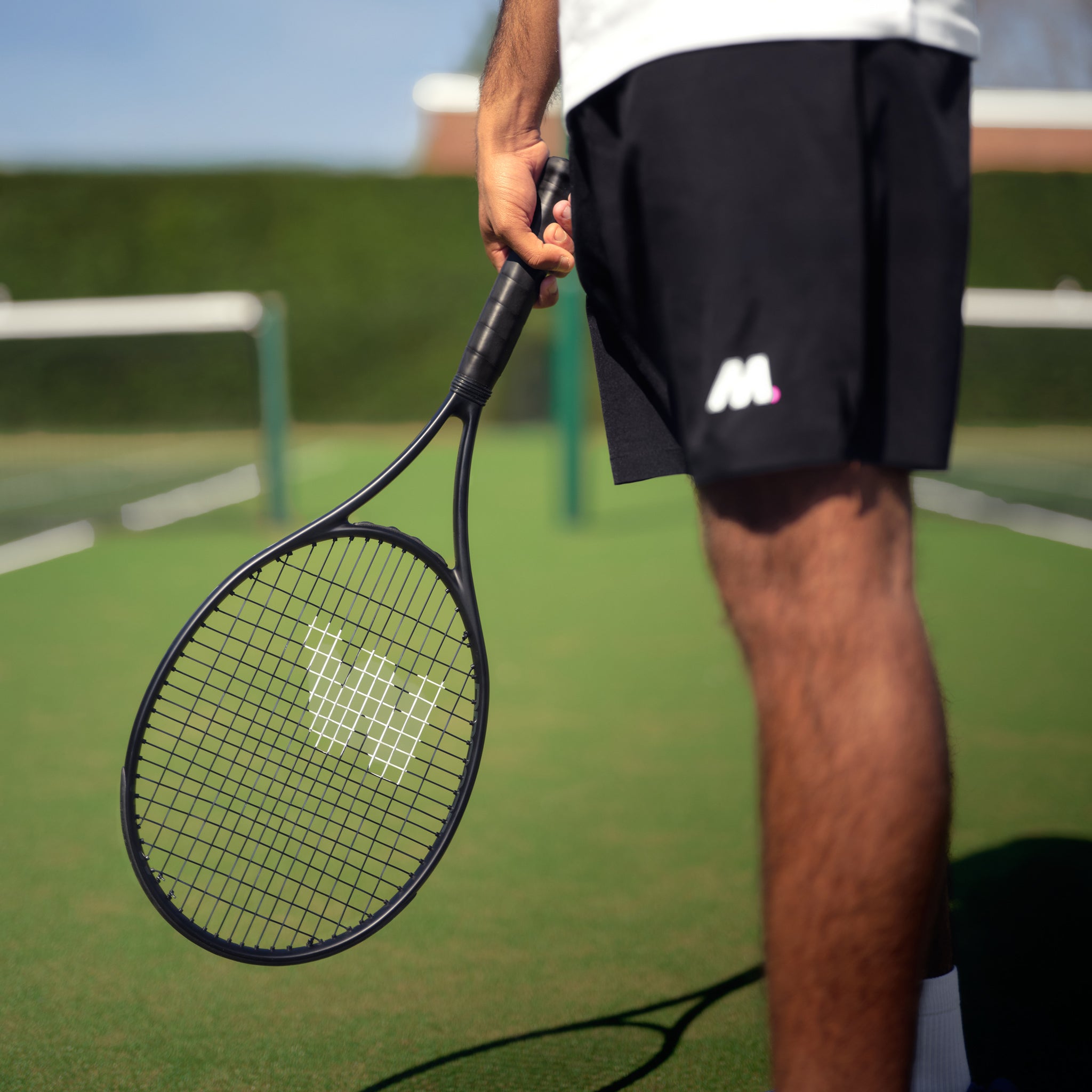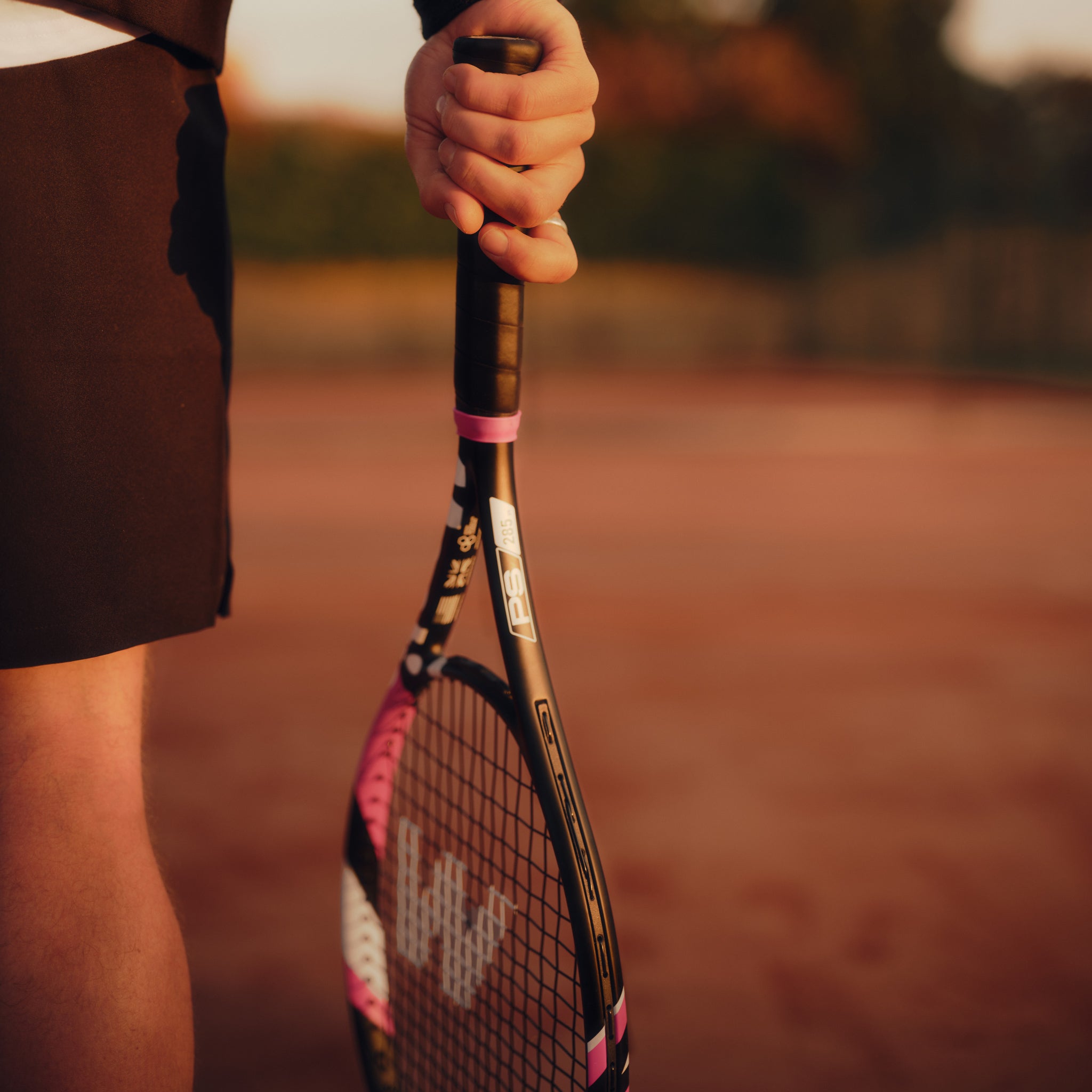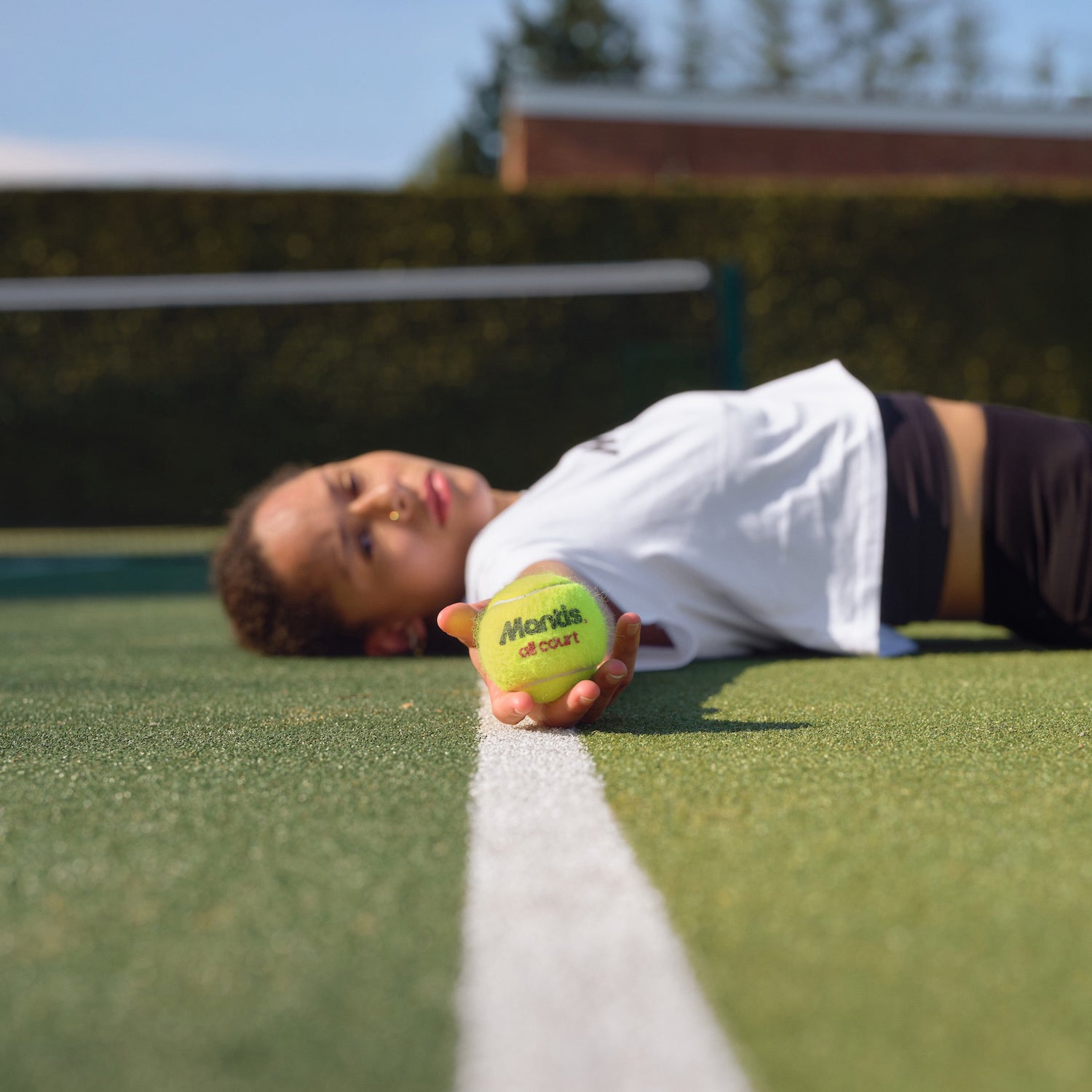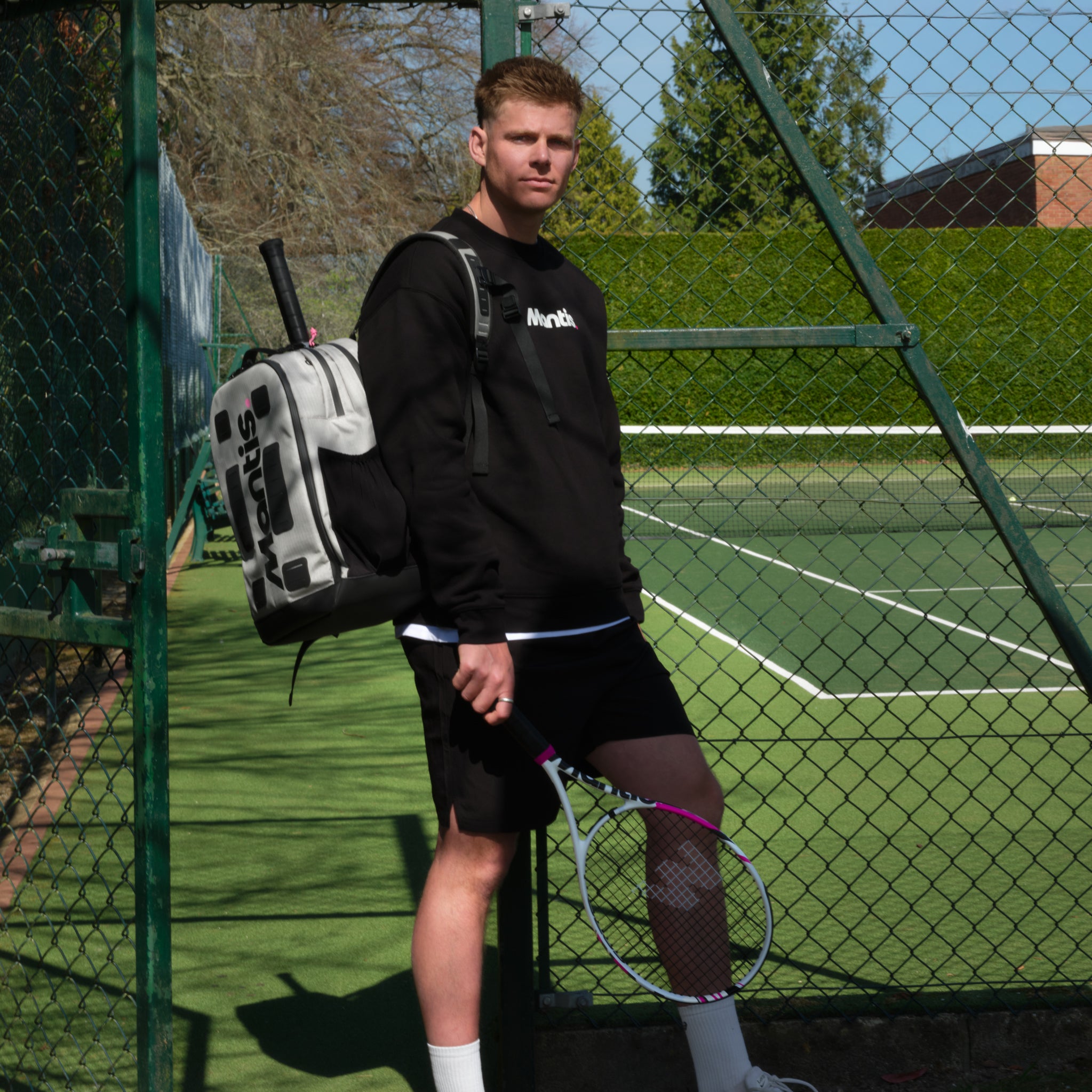
For players who value surgical precision over raw power, picking the right racket isn't just a choice—it's the first step to owning the court. Here at Mantis, we've always believed the best tennis rackets for control should feel like a natural extension of your arm, giving you the confidence to paint the lines, time and time again. This guide will help you understand what really makes a racket a control-oriented frame and our complete guide to understanding tennis racket specifications has you covered.
Unlocking Pinpoint Accuracy On the Court
When we talk about 'control' in tennis, what we really mean is the ability to place the ball exactly where you intend. It’s the difference between blasting a forehand and landing that same forehand just inside the baseline. Brute force can certainly win you points, but it’s that pinpoint accuracy that consistently wins matches.
We're going to cut through the marketing noise and get into the technical specs that work together to give you a better feel and command over the ball. Think of a control racket as a finely-tuned instrument; its job is to translate your intentions into on-court reality.
The Foundation of Racket Control
To grasp what makes a racket excel at control, you have to look at its core design. We’ll be breaking down the key characteristics that set these frames apart from their power-focused cousins. These aren't just numbers on a spec sheet; they are the ingredients that create a stable, predictable, and responsive feel in your hand.
Finding your perfect frame is all about matching these technical specs to your personal playing style. The right control racket brings some serious advantages to your game:
- Enhanced Confidence: When you know your racket will do what you ask of it, you swing more freely and start aiming for smaller targets.
- Greater Consistency: A stable frame helps you replicate your best shots more often, which is the key to cutting down on those frustrating unforced errors.
- Superior Touch and Feel: Better feedback from the string bed is what allows for those deft drop shots, sharp angles, and crisp volleys.
At Mantis, we build equipment for players who live for progress. We obsess over every gram of weight and the quality of our materials because we know genuine performance comes from purposeful design, not flashy gimmicks.
So, whether you're a tactical baseliner who loves to work the angles or an all-court player who thrives on touch and finesse, we'll help you decode the science behind racket design. By the time you're done here, you’ll have the knowledge to pick a frame that truly elevates your entire game.
What Defines a True Control Racket
When we talk about 'control' in tennis, it’s about so much more than just pointing the racket where you want the ball to go. True control is about feel. It's the confidence you get from the racket's feedback on every single shot. At Mantis, we believe the DNA of a great control frame is one that rewards good technique and surgical precision.
To really find the best tennis rackets for control, you first need to understand what makes them so different from their power-focused cousins.
Think of it like using a fine-tipped artist's pen versus a thick permanent marker. A power racket is the marker—it gives you a big, bold result with very little effort. A control racket, on the other hand, is the artist's pen. It delivers pinpoint accuracy, letting you craft nuanced shots where you are the one generating the pace.
This difference all starts with a core concept: dwell time. This is the tiny fraction of a second that the ball stays on the strings at impact. A racket built with a more flexible frame will naturally increase this dwell time, giving you that satisfying, connected feeling when you strike the ball perfectly.
The Importance of Dwell Time and Feel
Why does that split-second matter so much? Because a longer dwell time is the secret ingredient for control. When the ball sinks into the string bed for just a moment longer, it opens a crucial window for you to influence its journey. It’s in that moment that you can add extra spin, adjust your angle to clear the net, or softly guide a drop shot over the net with purpose.
Put simply, a longer dwell time means your technique translates directly into predictable results. It’s why so many advanced players say their favourite racket feels like an extension of their arm. That enhanced feel is the difference between hoping the ball goes in and knowing it will.
A true control racket doesn’t create the shot for you; it empowers you to create the shot you envision. The frame provides the stability and predictability, while your skill dictates the outcome.
Material and Technological Influence
This kind of responsive performance doesn't happen by chance. Modern racket technology and materials play a huge role in giving players the control they crave, particularly here in the UK. Manufacturers now use high-modulus graphite and fine-tune frame stiffness to give rackets incredible stability without piling on the weight.
This focus on precision isn't just a niche trend. Recent figures suggest that around 60% of racket sales in the UK are now for frames with technology designed to improve control, not just raw power. It’s a clear shift, backed by coaching philosophies in tennis clubs up and down the country. You can dive deeper into these UK tennis equipment market trends to see the full picture.
With this foundation in feel, dwell time, and materials, you're ready to look at the specific numbers that make it all happen. Let's explore how specs like head size, weight, and balance come together to create the ultimate control racket.
Decoding racket specs about the best tennis rackets for control
Translating abstract ideas like 'feel' and 'dwell time' into a concrete racket choice means you’ve got to get comfortable with the numbers on the spec sheet. These aren't just for show; they're the blueprint for how a racket will perform in your hands. To get you evaluating frames like a pro, we'll break down the most critical specs that define a control racket. If you want to dive even deeper, our complete guide to understanding tennis racket specifications has you covered.
Think of it like tuning a high-performance car. A small adjustment to one setting can completely change how it feels and handles. By learning what each number means, you can start to piece together the perfect combination that clicks with your game and gives you the pinpoint accuracy you're chasing.
Head Size and the Sweet Spot
The first spec most players look at is head size, measured in square inches. When you’re gunning for maximum control, the general rule is that smaller is better.
- Smaller Heads (95-98 sq. in.): These frames give you a very concentrated and responsive sweet spot. They aren't as forgiving if you miss-hit, but when you connect cleanly, the feedback and precision are unmatched. The smaller surface area also resists twisting on impact, which translates directly to more predictable shots.
- Larger Heads (100+ sq. in.): Going bigger gets you more power and a larger, more generous sweet spot, but you sacrifice some of that raw, connected feel that's crucial for precision.
Choosing a smaller head size is a trade-off. You're swapping a bit of forgiveness for a massive gain in your ability to direct the ball exactly where you want it to go.
A smaller head size acts like a magnifying glass for your technique. It rewards clean, precise contact with exceptional accuracy, forcing you to focus on your swing mechanics.
Weight, Balance, and Stability
Heavier rackets are the foundation of stability. A frame weighing over 310 grams (unstrung) simply won't get pushed around by a heavy, incoming shot. This stability is absolutely vital for control because it keeps the racket face steady right through the point of contact.
This is particularly true in the UK, where a tactical, all-court game is often prized. The UK actually accounts for around 13.32% of the entire European tennis racket market, making it a key region for players who value precision. We're seeing a clear trend where British players are gravitating towards rackets with smaller heads and higher static weights to really dial in their control.
But it’s not just about the total weight; it’s about where that weight is. This is where balance comes in. A head-light balance means more of the mass is shifted towards the handle. This clever trick makes an otherwise heavy racket feel surprisingly quick and easy to manoeuvre, especially up at the net. You get the solid stability you need without feeling like you're swinging a sledgehammer.
As you can see, the leading control frames are engineered with these precise specifications in mind, showing just how much focus the industry puts on delivering pinpoint accuracy.
Finding a Racket That Matches Your Game
Knowing the technical specs of a racket is one thing, but the real magic happens when you match them to your identity on the court. Even the best control racket in the world won't do you any good if it fights against your natural playing style. At Mantis, we’ve always believed that the right frame should feel like an extension of your arm, enhancing your strengths rather than forcing you into a mould that just isn't you.
So, let's connect the dots. By figuring out what kind of player you are, you can start to understand which technical features will genuinely help you, turning your racket from a piece of equipment into a true competitive edge.
The Aggressive Baseliner
Do you like to hang back on the baseline, dictating points with relentless, heavy groundstrokes? The aggressive baseliner’s game is all about generating your own pace and pushing your opponent off the court. You need a racket that can handle that power and provide a rock-solid feel at impact.
For this powerful style, here’s what to look for:
- Higher Static Weight: A heavier frame, anything above 310g, gives you the mass needed to plough through the ball. It won’t twist or flutter in your hand, even when you’re facing serious heat from your opponent.
- Head-Light Balance: This is the key to making that heavy frame feel manageable. A head-light balance lets you whip the racket head through the contact zone with speed, essential for generating punishing topspin and pace.
- Dense String Pattern (18x20): This pattern offers a super-connected and predictable response off the stringbed. It's perfect for players who hit a flatter ball and love to paint the lines with precision.
The All-Court Tactician
Are you the chameleon of the court? The player who’s just as comfortable grinding from the baseline as you are finishing points at the net? All-court tacticians transition seamlessly from defence to offence, using variety and court positioning to outsmart their opponents. This adaptable style demands a racket that’s just as versatile.
A tactician’s perfect frame is a balancing act. We find that a moderate weight (think 300-310g) paired with a head-light balance hits the sweet spot. This gives you enough substance for solid groundstrokes but keeps the racket nimble enough for quick-fire volleys and reaction shots. A more open 16x19 string pattern often helps, giving you that extra bite to dip passing shots at your opponent’s feet.
The goal is not to find a single 'best' racket, but to find the best fit for your mechanics and strategy. Your equipment should work with you, not against you.
The Counter-Puncher
If your game is all about frustrating consistency and using your opponent’s power against them, then you’re a classic counter-puncher. You are the wall. You get every ball back, patiently waiting for an error or a short ball you can pounce on. Your racket needs to be quick, forgiving, and brilliant at redirecting pace.
For this playing style, we'd point you towards a slightly lighter, more head-light frame. This setup allows for rapid swing adjustments and helps you get your racket on balls you have no right to reach. A more flexible frame (with a lower RA rating) also improves feel and ball pocketing, giving you the delicate touch needed for those pinpoint passing shots and lobs. It’s all about absorbing their power and placing the ball with infuriating accuracy.
How Strings and Tension Fine-Tune Your Precision
Finding a perfectly engineered frame is a huge step, but it’s only half the story when you're chasing ultimate control. Your string setup is the other half of the equation, the bit that truly personalises the racket to your game.
Here at Mantis, we see it all the time: the right strings and tension can completely transform how a racket feels and performs, turning a great frame into an extension of your arm. For a much deeper dive into the world of strings, our complete tennis string guide is the perfect place to start.
Think of your strings as the very soul of the racket. The frame provides the body and structure, but the strings dictate the nuance of every single shot. Dialling in your string setup is one of the fastest and most effective ways to customise your racket's performance for the court.
Choosing Your String Material
The material your string is made from has a massive impact on feel, durability, and, of course, control. For players who live and die by their precision, the choice usually boils down to two main camps.
-
Polyester Strings: These have become the go-to for advanced players who bring their own power with fast, full swings. Poly strings give you a firm, low-powered response, which is exactly what you need to swing out aggressively without worrying about the ball sailing long. The compromise? They're stiffer and can be a bit harsh on the arm if you're sensitive.
-
Multifilament Strings: Built by weaving hundreds of tiny fibres together, these strings are designed to replicate the plush feel of natural gut. They deliver exceptional comfort and touch, making them a brilliant choice for players who rely on finesse, delicate drop shots, and crisp volleys.
The Tension Trade-Off: Power vs Control
String tension, measured in pounds or kilograms, is the final piece of this puzzle. It directly affects how much the string bed "pockets" the ball on impact, creating a fundamental trade-off every player needs to understand.
There’s a common myth that tighter is always better. The truth is, it's a delicate balancing act. Higher tension gives you more control by deadening the 'trampoline effect,' while lower tension provides more free power and comfort.
For players whose main goal is precision, a higher tension is usually the way to go. It creates a more predictable and uniform response from the string bed, which is absolutely vital for hitting your targets. A smart approach is to start in the middle of your racket's recommended tension range and then tweak it up or down from there based on how it feels.
This demand for precise equipment is clear in the market. The UK tennis equipment market was valued at around USD 150.45 million recently and is set to grow, largely because players are increasingly seeking out rackets that give them an edge in accuracy. Don't be afraid to experiment with small adjustments – that final tweak could unlock the level of precision you’ve been looking for or ask your coach or another tennis expert for advice as they are normally very experienced.
Finding Your Ultimate Control Racket
The quest for the perfect control racket is less about finding the single "best" one and more about discovering the right one for you. It’s a very personal decision, a blend of science and feel that has to match your specific style of play.
We've walked through the key ingredients: a smaller head size for precision, a hefty static weight with a head-light balance for stability, a flexible frame for feel, and a dense string pattern for that predictable response. When these elements work together, they create a racket that becomes an extension of your arm—stable, reliable, and incredibly responsive.
But all this theory only gets you so far. We can't stress this enough: you have to demo different rackets. Getting them on the court is the only way to truly understand how these specs translate into real-world performance. It's that hands-on experience that bridges the gap between reading about a racket and knowing it’s the one.
Of course, the best gear in the world won't help if you're not physically ready to play. Staying healthy and managing your body is crucial for maintaining consistency and pushing your game forward. For practical advice on keeping your body in top shape, check out these tips on preventing sports injuries.
The right control racket does more than just tighten your shot groups; it fundamentally builds your confidence. When you have complete trust in your frame, you'll find yourself aiming for the lines and attempting shots you wouldn't have dared to before.
Hopefully, this guide has armed you with the knowledge to confidently choose a racket that puts you in command. The right frame won't just elevate your game—it will deepen your enjoyment and turn every point into a new opportunity to paint the court with precision.
Got Questions About Control Rackets? We've Got Answers.
Choosing a racket is a big decision, and when you're zeroing in on a control frame, a few questions always pop up. We get it. At Mantis, we've helped countless players find their perfect match, so we’ve put together some straight-talking answers to the queries we hear most often.
Think of this as a final checkpoint to help you feel confident in your choice and get you on the court with the right tool for the job.
Are Control Rackets a Good Place for Beginners to Start?
It's a fair question. While anyone can start with a control racket, we generally find that frames with bigger sweet spots and a bit more free power are more forgiving when you're just learning the ropes. They make those early days on the court a lot more fun.
That said, if you're a beginner with great hand-eye coordination and a real commitment to building solid technique from the get-go, a lighter, more flexible control frame could be a smart move. Our usual advice at Mantis? Start with a racket that offers a good blend of power and control, then graduate to a more specialised frame as your game develops.
Will I Lose Too Much Power by Switching to a Control Racket?
This is probably the biggest worry we hear, but the trade-off isn't as severe as you might imagine. Modern control rackets aren't the unforgiving planks of wood they used to be; advanced materials give them fantastic stability and a satisfying pop at impact.
The deal is simple: you bring the power, and the racket channels it with precision. If you already have a naturally fast, full swing, you're creating plenty of your own pace. A control racket just helps you direct that power exactly where you want it to go.
How Often Should I Restring to Keep That 'Controlled' Feel?
Don't overlook your strings! They lose tension over time, and when they do, your control and feel go right out the window. A brilliant rule of thumb is to restring as many times per year as you play per week.
So, if you play three times a week, plan on getting a restring about three times a year. Of course, serious competitors using polyester strings will need to do it far more often, as those strings lose their responsive feel and go 'dead' much quicker.
At Mantis, we obsess over the details because we know that true performance comes from purposeful design. Explore our range of expertly crafted equipment built for players who live for progress. https://mantissport.com








